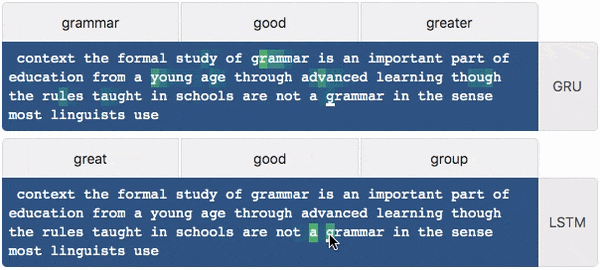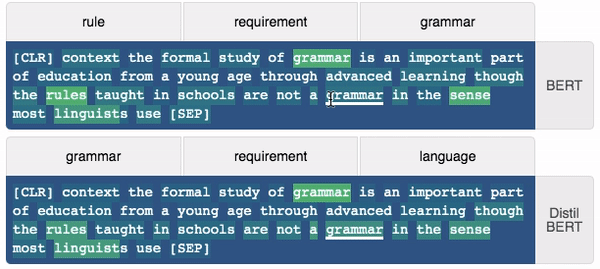AndreasMadsen / Python Textualheatmap
Labels
Projects that are alternatives of or similar to Python Textualheatmap
textualheatmap
Create interactive textual heatmaps for Jupiter notebooks.
I originally published this visualization method in my distill paper https://distill.pub/2019/memorization-in-rnns/. In this context, it is used as a saliency map for showing which parts of a sentence are used to predict the next word. However, the visualization method is more general-purpose than that and can be used for any kind of textual heatmap purposes.
textualheatmap works with python 3.6 or newer and is distributed under the
MIT license.
An end-to-end example of how to use the HuggingFace 🤗 Transformers python module to create a textual saliency map for how each masked token is predicted.
Install
pip install -U textualheatmap
API
Examples
Example of sequential-charecter model with metadata visible
from textualheatmap import TextualHeatmap
data = [[
# GRU data
{"token":" ",
"meta":["the","one","of"],
"heat":[1,0,0,0,0,0,0,0,0]},
{"token":"c",
"meta":["can","called","century"],
"heat":[1,0.22,0,0,0,0,0,0,0]},
{"token":"o",
"meta":["country","could","company"],
"heat":[0.57,0.059,1,0,0,0,0,0,0]},
{"token":"n",
"meta":["control","considered","construction"],
"heat":[1,0.20,0.11,0.84,0,0,0,0,0]},
{"token":"t",
"meta":["control","continued","continental"],
"heat":[0.27,0.17,0.052,0.44,1,0,0,0,0]},
{"token":"e",
"meta":["context","content","contested"],
"heat":[0.17,0.039,0.034,0.22,1,0.53,0,0,0]},
{"token":"x",
"meta":["context","contexts","contemporary"],
"heat":[0.17,0.0044,0.021,0.17,1,0.90,0.48,0,0]},
{"token":"t",
"meta":["context","contexts","contentious"],
"heat":[0.14,0.011,0.034,0.14,0.68,1,0.80,0.86,0]},
{"token":" ",
"meta":["of","and","the"],
"heat":[0.014,0.0063,0.0044,0.011,0.034,0.10,0.32,0.28,1]},
# ...
],[
# LSTM data
# ...
]]
heatmap = TextualHeatmap(
width = 600,
show_meta = True,
facet_titles = ['GRU', 'LSTM']
)
# Set data and render plot, this can be called again to replace
# the data.
heatmap.set_data(data)
# Focus on the token with the given index. Especially useful when
# `interactive=False` is used in `TextualHeatmap`.
heatmap.highlight(159)
Example of sequential-charecter model without metadata
When show_meta is not True, the meta part of the data object has no effect.
heatmap = TextualHeatmap(
facet_titles = ['LSTM', 'GRU'],
rotate_facet_titles = True
)
heatmap.set_data(data)
heatmap.highlight(159)
Example of non-sequential-word model
format = True can be set in the data object to inducate tokens that are
not directly used by the model. This is useful if word or sub-word tokenization
is used.
data = [[
{'token': '[CLR]',
'meta': ['', '', ''],
'heat': [1, 0, 0, 0, 0, ...]},
{'token': ' ',
'format': True},
{'token': 'context',
'meta': ['today', 'and', 'thus'],
'heat': [0.13, 0.40, 0.23, 1.0, 0.56, ...]},
{'token': ' ',
'format': True},
{'token': 'the',
'meta': ['##ual', 'the', '##ually'],
'heat': [0.11, 1.0, 0.34, 0.58, 0.59, ...]},
{'token': ' ',
'format': True},
{'token': 'formal',
'meta': ['formal', 'academic', 'systematic'],
'heat': [0.13, 0.74, 0.26, 0.35, 1.0, ...]},
{'token': ' ',
'format': True},
{'token': 'study',
'meta': ['##ization', 'study', '##ity'],
'heat': [0.09, 0.27, 0.19, 1.0, 0.26, ...]}
]]
heatmap = TextualHeatmap(facet_titles = ['BERT'], show_meta=True)
heatmap.set_data(data)
Citation
If you use this in a publication, please cite my Distill publication where I first demonstrated this visualization method.
@article{madsen2019visualizing,
author = {Madsen, Andreas},
title = {Visualizing memorization in RNNs},
journal = {Distill},
year = {2019},
note = {https://distill.pub/2019/memorization-in-rnns},
doi = {10.23915/distill.00016}
}
Sponsor
Sponsored by NearForm Research.




